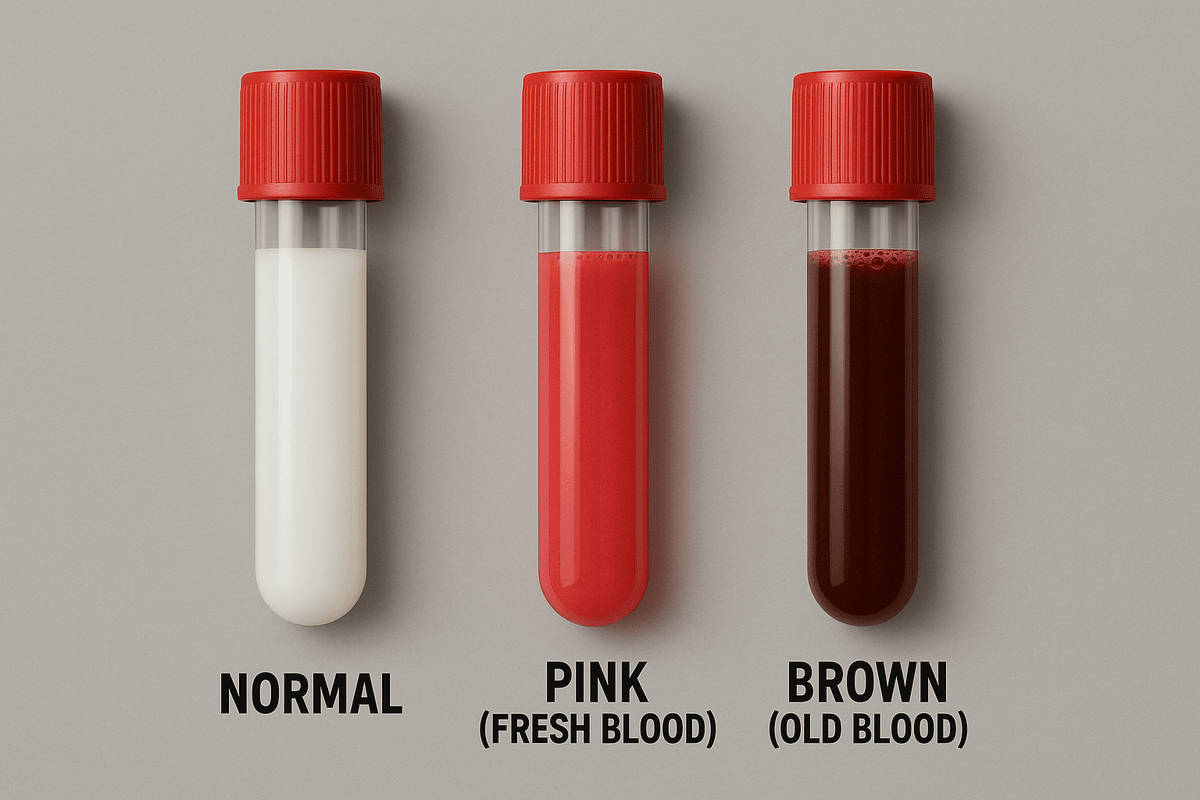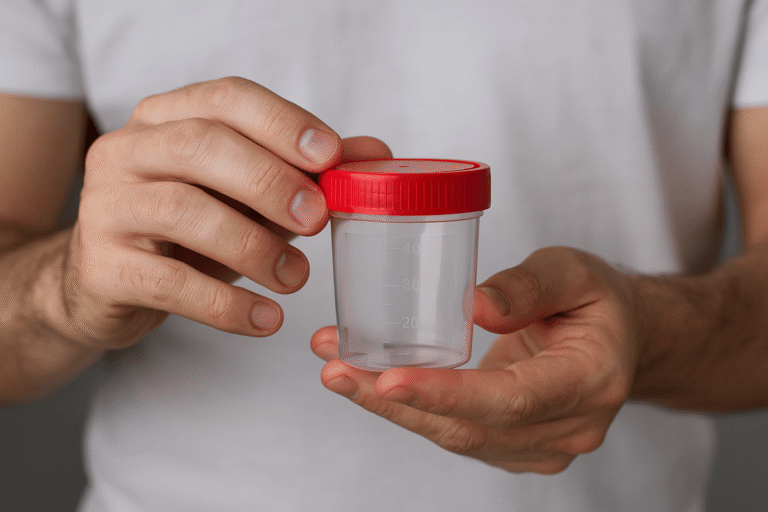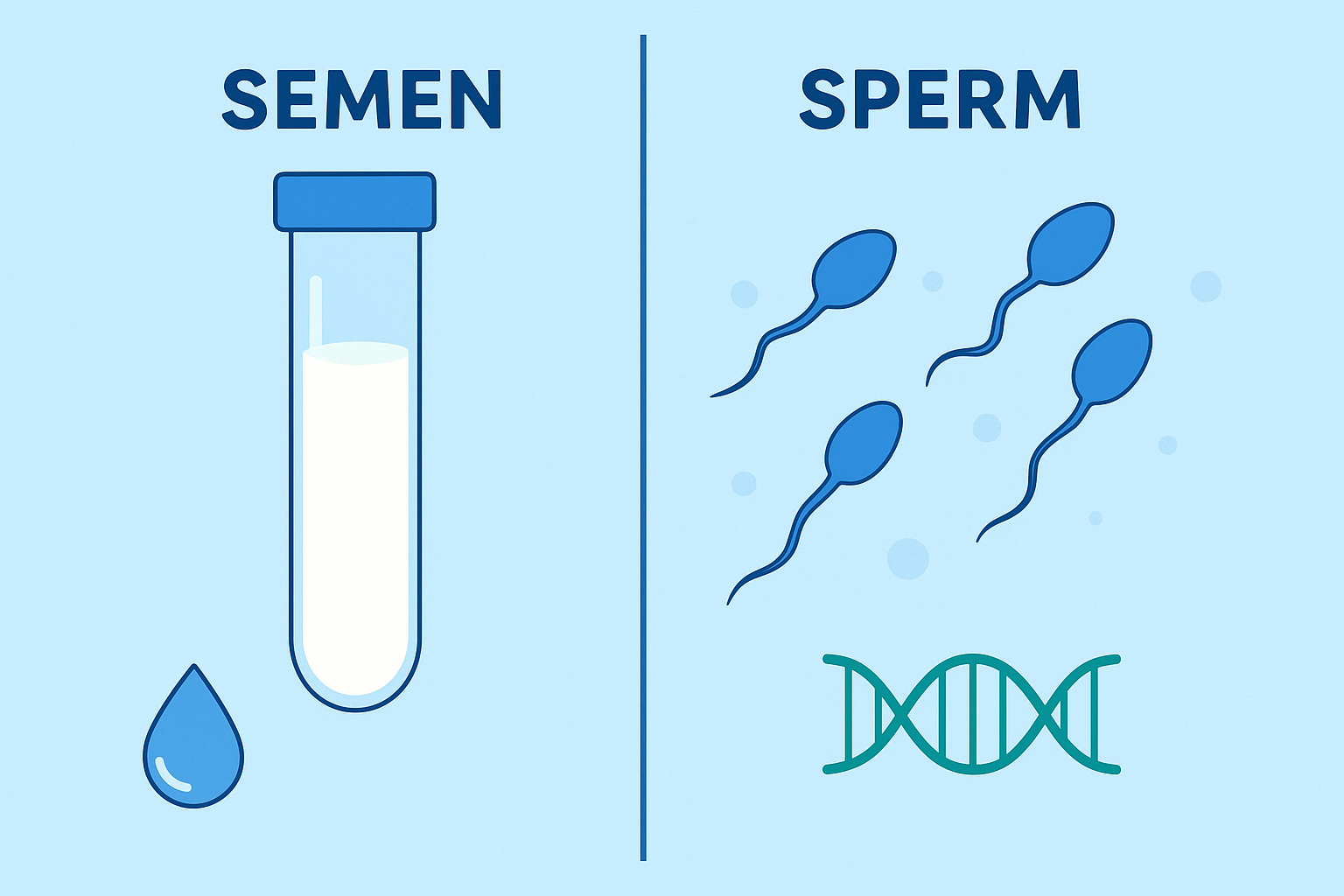It’s normal to feel a rush of fear when you see blood in your sperm after you ejaculate, whether it’s a bright crimson streak, a rusty pink hue, or a brown tinge that makes you worry. Hematoma, a medical term, can be frightening because it can cause anxiety about your health, fertility, and relationships. Seeing blood in sperm is shocking, but it’s important to know that such an event happens a lot and usually doesn’t mean you have a serious ailment. But it should never be overlooked.
This detailed guide goes over possible reasons, answers the important question “Is blood in sperm a sign of cancer?”, explains situations like blood in sperm but not urine with no discomfort, and looks at worries like “Can blood in sperm affect a woman?” With the right information, you can manage this symptom clearly and take the measures you need to feel better and remain healthy.
What Exactly Is Blood in Sperm (Hematospermia)?
Blood in sperm means you may see red blood cells in the semen, which is the fluid released during orgasm. Numerous glands produce semen, a complex mixture that includes fluid (mostly from the seminal vesicles), secretions from the prostate gland and bulbourethral glands (or Cowper’s glands), and sperm from the testicles. Blood can enter this mix at any point, such as from the testicles and epididymis, through the vas deferens tubes, within the prostate gland, the seminal vesicles, or even the urethra, which runs into the penis. The look can change a lot.
When fresh blood comes out, it typically looks like brilliant crimson streaks or a solid pink tone. Semen may seem brownish or like coffee grounds if it includes older blood in it that has had time to break down. It’s vital to know the difference between real blood in sperm and blood that comes from the urethra or a partner and may mingle with semen during sex, but isn’t hematospermia itself. The first important thing to notice is the unique quality of the blood in the ejaculate itself.
Best Exercises for Men to Improve Their Sperm Health
Unpacking the Potential Causes
Many different causes can lead to blood in sperm, ranging from minor, easily treatable issues to more serious conditions requiring medical care. Knowing what causes these symptoms can help you put them in context and lower your stress, but you still need to see a doctor.
Infections and Inflammatory Conditions
Inflammation and infection in the male reproductive system are two of the most common causes of blood in sperm. Inflammation, swelling, or infection in the male reproductive system can rupture small blood vessels, causing blood to mix with semen. Some common inflammatory disorders are:
- Prostatitis: The prostate gland becomes inflamed. It might be bacterial (acute or chronic) or non-bacterial (chronic pelvic discomfort syndrome). When the prostate tissue is inflamed, it becomes weak and bleeds easily, especially when the gland contracts rigidly during ejaculation.
- Urethritis: This is when the urethra becomes inflamed. This can happen because of sexually transmitted infections (STIs) like chlamydia or gonorrhea, or it can happen for other reasons. The irritated lining of the urethra might bleed right into the semen as it passes.
- Epididymitis: swelling of the epididymis, the coiled tube at the rear of the testicle where sperm matures. Infections, such as STDs or bacteria in the urinary tract, or injuries, can make things swell and bleed.
- Seminal vesiculitis: This is a less frequent kind of inflammation of the seminal vesicles, which are the glands that make most of the semen fluid. If you have an infection or congestion in the seminal vesicles, it might result in a significant amount of blood in your sperm.
- Sexually Transmitted Diseases (STIs): In addition to urethritis, diseases like chlamydia, gonorrhea, herpes, or trichomoniasis can make different sections of the reproductive system swell and develop ulcers, which can cause bleeding.
Trauma, Medical Procedures, and Vigorous Activity
Another big reason for blood in sperm is damage to the delicate tissues and blood vessels in the reproductive organs.
- Recent Medical Procedures: Recent medical procedures involving the prostate, urethra, or other regions are common causes of blood in sperm. This might involve a prostate biopsy (taking tissue samples), transurethral resection of the prostate (TURP) for BPH, a vasectomy, a cystoscopy (looking at the bladder with a camera), or even a really severe prostate massage. Bleeding might persist for a few weeks after that.
- Genital or Pelvic Trauma: A direct injury to the testicles, perineum (the area between the scrotum and anus), or pelvis can damage semen-producing or transporting structures, leading to blood in the sperm.
- Vigorous Sexual Activity: Usually, this resolves itself. Prolonged or frequent intercourse or masturbation can sometimes injure the urethra or prostate, leading to temporary bleeding. Such bleeding generally stops on its own.
Structural Abnormalities, Blockages, and Growths
Bleeding can happen when there are physical barriers or strange growths in the reproductive tract:
- Ejaculatory Duct Obstruction: This is when the ducts that deliver sperm and seminal fluid into the urethra are blocked. Cysts (such as Mullerian duct cysts or seminal vesicle cysts), stones (calculi) that grow in the ducts or prostate, or scarring from an infection or inflammation that happened before can all be to blame. The obstruction might make the pressure rise and the vessels break.
- Benign Prostatic Hyperplasia (BPH): This is when the prostate gland gets bigger. It happens a lot in elderly men. The bigger gland receives more blood, and the blood vessels on its surface might be weaker and more likely to break, especially when you ejaculate.
- Varicose Veins (Varices): Like varicose veins in the legs, veins near the prostate or seminal vesicles can become bigger and weaker. These veins can easily let blood enter the semen.
- Polyps or Tumors: Less often, benign polyps in the urethra, prostate, or seminal vesicles, or malignant tumors can cause bleeding.
Systemic Health Conditions and Bleeding Disorders
Blood in sperm can also be a sign of bigger health problems that impact the body’s ability to clot blood or the strength of its blood vessels:
- Severe Hypertension (High Blood Pressure): Very high, uncontrolled blood pressure can damage tiny blood vessels all across the body, including in the reproductive tract.
- Liver illness: Advanced liver illness, such as cirrhosis, can make it harder for the body to make clotting factors, which makes it more likely that blood will flow from different places.
- Bleeding Disorders: Conditions like hemophilia or von Willebrand disease, along with taking blood-thinning medications (like warfarin, heparin, rivaroxaban, apixaban, aspirin, or clopidogrel), greatly raise the chance of bleeding from small injuries or weak blood vessels, which can lead to blood showing up in sperm.
Also Read : Role Of Myo & D-Chiro Inositol In Fertility
Is Blood in Sperm a Sign of Cancer?
Men often fear that the presence of blood in sperm indicates cancer, particularly prostate, testicular, or bladder cancer. It’s important to face this head-on: Cancer can cause hematospermia, but it is statistically rare, especially in younger men and especially when hematospermia is the sole symptom. Blood in sperm is most often linked to prostate cancer; however, hematospermia is not a typical first indication of the disease. Even rarer causes are cancers of the urethra, bladder, seminal vesicles, or testicles. It’s also worth noting that men over 40 are more likely to have cancer, especially if they have blood in their sperm that doesn’t go away and is accompanied by other “red flag” symptoms like
- Trouble peeing (poor stream, hesitation, and needing to pee a lot, especially at night)
- Urinating or ejaculating hurt
- Hematuria, or blood in the urine
- Constant discomfort in the hips, lower back, pelvis, or testicles
- Losing weight or feeling tired for no reason
Don’t freak out, but don’t dismiss what you need to know. Even if the chances are in favor of a benign cause, especially in younger men who have just one episode, the risk of cancer makes it even more important to see a doctor to find out exactly why your sperm has blood in it. It is very beneficial to rule out dangerous problems.
Can Blood in Sperm Affect a Woman?
When it comes to sexual health and intimacy, the subject of “Can blood in sperm affect a woman?” comes up a lot. Here’s how it works:
- The Blood Itself: Having blood in semen alone is very unlikely to hurt a female companion directly. Blood in semen doesn’t hurt vaginal tissues or make you sick on its own.
- Underlying Infection (STIs): This is the most important issue. Sexually transmitted infections (STIs) like chlamydia, gonorrhea, or trichomoniasis can cause blood in sperm and may spread the infection further. The contaminated semen, whether or not it has visible blood, can pass the STI on to the partner during unprotected intercourse. The infection might lead to pelvic inflammatory disease (PID), infertility, or other problems.
- Viral Infections: It’s less frequent, but if the bleeding is caused by an active viral illness like herpes or HIV in semen, it can be spread.
- Emotional Impact: Seeing blood can make both couples feel anxious, scared, or less close to each other, in addition to affecting their physical health.
Yes, blood in sperm can affect a woman if an STI or other transmissible infection causes the bleeding. If a STI or other potentially transmissible virus causes the bleeding, the answer is most likely YES. Until the cause of blood in sperm is found and both parties are treated, it is highly recommended that they use protection. During this time of research, it is very important to use condoms to keep your partner safe.
What is hyperprolactinemia? How High Prolactin Levels Affect Your Energy and Ability to Get Pregnant
Treatment Options: Resolving Blood in Sperm
The diagnostic process largely determines the treatment for blood in sperm.
Observation & Reassurance
For a single, isolated episode without concerning symptoms, especially in younger men, when no clear cause is found, doctors often recommend simple observation. Many instances go away on their own.
Antibiotics
Antibiotics are administered for bacterial infections like prostatitis, epididymitis, urethritis, or seminal vesiculitis. A comprehensive course is vital.
Anti-inflammatory Medications
These are used to lower inflammation in illnesses like prostatitis or urethritis. They can assist with symptoms and may even stop bleeding.
Treatment of STIs
You need the right antibiotics or antivirals. It is very important that sexual partners also be tested and treated to stop the illness from coming back.
Managing BPH
Doctors may use medications like alpha-blockers or 5-alpha reductase inhibitors, or perform surgeries such as TURP or laser procedures, to shrink the prostate or remove blockages and stop associated bleeding.
Discontinuation/Adjustment of Blood Thinners
If a doctor believes it is safe and feasible, they may recommend discontinuing or adjusting the dosage of anticoagulant or antiplatelet drugs that are causing persistent bleeding. You should never stop taking these drugs without talking to your doctor first.
Surgical Intervention
Needed for certain structural problems:
- Cyst Drainage or Removal: For cysts that are big or causing problems and are obstructing ducts.
- Stone Removal: To get rid of stones in the seminal vesicles or ejaculatory ducts.
- Varicocele Embolization: To stop veins from becoming bigger.
- Cancer Treatment: If you have cancer (such as prostate, testicular, etc.), there are several ways to treat it depending on the kind and stage. These include surgery, radiation therapy, hormone therapy, and chemotherapy.
In conclusion, being knowledgeable and proactive about your health is essential
Finding blood in sperm is really scary. However, understanding that infections, inflammation, or minor injuries typically cause pain and are treatable can greatly assist. Keep in mind that the question, “Is blood in sperm a sign of cancer?” is a positive one, but cancer is not a very prevalent cause, especially in younger men. Blood in sperm but not urine is a common sign of a problem in the reproductive system, and the fact that there is no discomfort (blood in sperm but not pee, no pain) does not mean that an assessment is not needed.
Addressing “Can blood in sperm affect a woman?” is essential since it shows how important STD testing and protecting your partner are if an infection is the cause. The most important thing you can do is see a urologist or your primary care doctor. If you ignore hematospermia, no matter what other symptoms you have, you could miss a treatable condition or have to wait for a crucial diagnosis. By getting a medical checkup on time, you may get clear answers, get the right treatment if you need it, and feel better about taking charge of your reproductive and general health. Don’t allow fear to stop you from doing things. Instead, offer yourself strength by learning and taking action.




